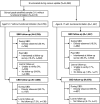Disability in childhood and the equity of health services: a cross-sectional comparison of mass drug administration strategies for soil-transmitted helminths in southern Malawi
- PMID: 39242171
- PMCID: PMC11381638
- DOI: 10.1136/bmjopen-2023-083321
Disability in childhood and the equity of health services: a cross-sectional comparison of mass drug administration strategies for soil-transmitted helminths in southern Malawi
Abstract
Background: School-based approaches are an efficient mechanism for the delivery of basic health services, but may result in the exclusion of children with disabilities if they are less likely to participate in schooling. Community-based 'door to door' approaches may provide a more equitable strategy to ensure that children with disabilities are reached, but disability is rarely assessed rigorously in the evaluation of health interventions.
Objectives: To describe the prevalence and factors associated with disability among children aged 5-17 years and to assess the relative effectiveness of routine school-based deworming (SBD) compared with a novel intervention of community-based deworming (CBD) in treating children with disabilities for soil-transmitted helminths.
Setting: DeWorm3 Malawi Site (DMS), Mangochi district, Malawi.
Participants: All 44 574 children aged 5-17 years residing within the DMS.
Primary and secondary outcome measures: Disability was defined as a functional limitation in one or more domains of the Washington Group/UNICEF Child Functioning Module administered as part of a community-based census. Treatment of all children during SBD and CBD was independently observed and recorded. For both intervention types, we performed bivariate analyses (z-score) of the absolute proportion of children with and without disabilities treated (absolute differences (ADs) in receipt of treatment), and logistic regression to examine whether disability status was associated with the likelihood of treatment (relative differences in receipt of treatment).
Results: The overall prevalence of disability was 3.3% (n=1467), and the most common domains of disability were hearing, remembering and communication. Boys were consistently more likely to have a disability compared with girls at all age groups, and disability was strongly associated with lower school attendance and worse levels of education. There was no significant difference in the proportion of children with disabilities treated during SBD when assessed by direct observation (-1% AD, p=0.41) or likelihood of treatment (adjusted risk ratio (aRR)=1.07, 95% CI 0.89 to 1.28). Treatment of all children during CBD was substantially higher than SBD, but again showed no significant difference in the proportions treated (-0.5% AD, p=0.59) or likelihood of treatment (aRR=1.04, 95% CI 0.99 to 1.10).
Conclusion: SBD does not appear to exclude children with disabilities, but the effect of consistently lower levels of educational participation of children with disabilities should be actively considered in the design and monitoring of school health interventions.
Trial registration number: NCT03014167.
Keywords: Disabled Persons; Mass Drug Administration; Neglected Diseases; Schools.
© Author(s) (or their employer(s)) 2024. Re-use permitted under CC BY. Published by BMJ.
Conflict of interest statement
Competing interests: None declared.
Figures
References
-
- United Nations Children’s Fund . Seen, counted, included: using data to shed light on the well-being of children with disabilities. New York: UNICEF; 2021.
-
- Graham N, Schultz L, Mitra S, et al. In: Child and adolescent health and development. Bundy DAP, Silva ND, Horton S, editors. Washington (DC): The International Bank for Reconstruction and Development / The World Bank; 2017. Disability in middle childhood and adolescence. - PubMed
-
- World Health Organization & World Bank . World report on disability 2011. Geneva: World Health Organization; 2011.
-
- Mizunoya S, Mitra S, Yamasaki I. Disability and school attendance in 15 low- and middle-income countries. World Dev. 2018;104:388–403. doi: 10.1016/j.worlddev.2017.12.001. - DOI
Publication types
MeSH terms
Substances
Associated data
LinkOut - more resources
Full Text Sources
Medical

